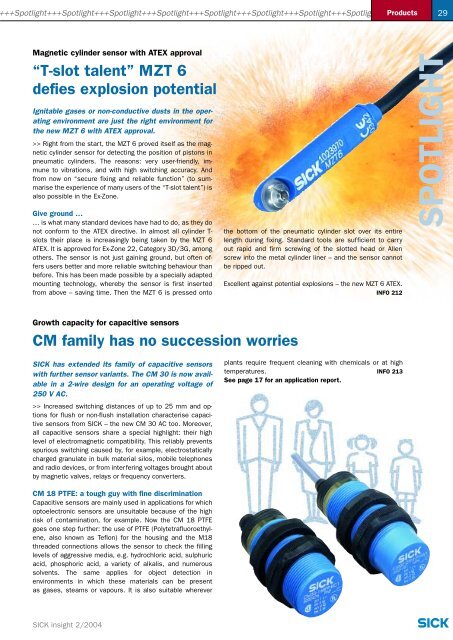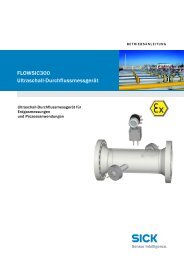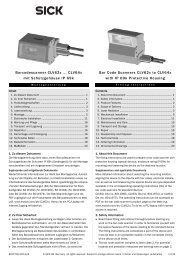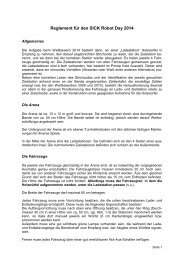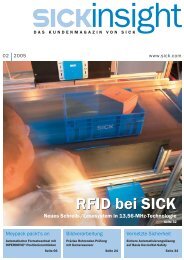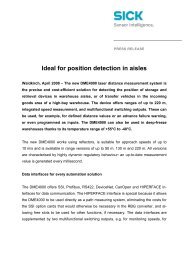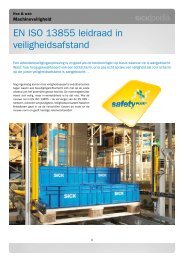10 years' success in the Middle Kingdom - Sick
10 years' success in the Middle Kingdom - Sick
10 years' success in the Middle Kingdom - Sick
Create successful ePaper yourself
Turn your PDF publications into a flip-book with our unique Google optimized e-Paper software.
++Spotlight+++Spotlight+++Spotlight+++Spotlight+++Spotlight+++Spotlight+++Spotlight+++Spotlight+++ Products<br />
Magnetic cyl<strong>in</strong>der sensor with ATEX approval<br />
“T-slot talent” MZT 6<br />
defies explosion potential<br />
Ignitable gases or non-conductive dusts <strong>in</strong> <strong>the</strong> operat<strong>in</strong>g<br />
environment are just <strong>the</strong> right environment for<br />
<strong>the</strong> new MZT 6 with ATEX approval.<br />
>> Right from <strong>the</strong> start, <strong>the</strong> MZT 6 proved itself as <strong>the</strong> magnetic<br />
cyl<strong>in</strong>der sensor for detect<strong>in</strong>g <strong>the</strong> position of pistons <strong>in</strong><br />
pneumatic cyl<strong>in</strong>ders. The reasons: very user-friendly, immune<br />
to vibrations, and with high switch<strong>in</strong>g accuracy. And<br />
from now on “secure fix<strong>in</strong>g and reliable function” (to summarise<br />
<strong>the</strong> experience of many users of <strong>the</strong> “T-slot talent”) is<br />
also possible <strong>in</strong> <strong>the</strong> Ex-Zone.<br />
Give ground …<br />
… is what many standard devices have had to do, as <strong>the</strong>y do<br />
not conform to <strong>the</strong> ATEX directive. In almost all cyl<strong>in</strong>der Tslots<br />
<strong>the</strong>ir place is <strong>in</strong>creas<strong>in</strong>gly be<strong>in</strong>g taken by <strong>the</strong> MZT 6<br />
ATEX. It is approved for Ex-Zone 22, Category 3D/3G, among<br />
o<strong>the</strong>rs. The sensor is not just ga<strong>in</strong><strong>in</strong>g ground, but often offers<br />
users better and more reliable switch<strong>in</strong>g behaviour than<br />
before. This has been made possible by a specially adapted<br />
mount<strong>in</strong>g technology, whereby <strong>the</strong> sensor is first <strong>in</strong>serted<br />
from above – sav<strong>in</strong>g time. Then <strong>the</strong> MZT 6 is pressed onto<br />
Growth capacity for capacitive sensors<br />
CM family has no <strong>success</strong>ion worries<br />
SICK has extended its family of capacitive sensors<br />
with fur<strong>the</strong>r sensor variants. The CM 30 is now available<br />
<strong>in</strong> a 2-wire design for an operat<strong>in</strong>g voltage of<br />
250 V AC.<br />
>> Increased switch<strong>in</strong>g distances of up to 25 mm and options<br />
for flush or non-flush <strong>in</strong>stallation characterise capacitive<br />
sensors from SICK – <strong>the</strong> new CM 30 AC too. Moreover,<br />
all capacitive sensors share a special highlight: <strong>the</strong>ir high<br />
level of electromagnetic compatibility. This reliably prevents<br />
spurious switch<strong>in</strong>g caused by, for example, electrostatically<br />
charged granulate <strong>in</strong> bulk material silos, mobile telephones<br />
and radio devices, or from <strong>in</strong>terfer<strong>in</strong>g voltages brought about<br />
by magnetic valves, relays or frequency converters.<br />
CM 18 PTFE: a tough guy with f<strong>in</strong>e discrim<strong>in</strong>ation<br />
Capacitive sensors are ma<strong>in</strong>ly used <strong>in</strong> applications for which<br />
optoelectronic sensors are unsuitable because of <strong>the</strong> high<br />
risk of contam<strong>in</strong>ation, for example. Now <strong>the</strong> CM 18 PTFE<br />
goes one step fur<strong>the</strong>r: <strong>the</strong> use of PTFE (Polytetrafluoroethylene,<br />
also known as Teflon) for <strong>the</strong> hous<strong>in</strong>g and <strong>the</strong> M18<br />
threaded connections allows <strong>the</strong> sensor to check <strong>the</strong> fill<strong>in</strong>g<br />
levels of aggressive media, e.g. hydrochloric acid, sulphuric<br />
acid, phosphoric acid, a variety of alkalis, and numerous<br />
solvents. The same applies for object detection <strong>in</strong><br />
environments <strong>in</strong> which <strong>the</strong>se materials can be present<br />
as gases, steams or vapours. It is also suitable wherever<br />
SICK <strong>in</strong>sight 2/2004<br />
<strong>the</strong> bottom of <strong>the</strong> pneumatic cyl<strong>in</strong>der slot over its entire<br />
length dur<strong>in</strong>g fix<strong>in</strong>g. Standard tools are sufficient to carry<br />
out rapid and firm screw<strong>in</strong>g of <strong>the</strong> slotted head or Allen<br />
screw <strong>in</strong>to <strong>the</strong> metal cyl<strong>in</strong>der l<strong>in</strong>er – and <strong>the</strong> sensor cannot<br />
be ripped out.<br />
Excellent aga<strong>in</strong>st potential explosions – <strong>the</strong> new MZT 6 ATEX.<br />
INFO 212<br />
plants require frequent clean<strong>in</strong>g with chemicals or at high<br />
temperatures. INFO 213<br />
See page 17 for an application report.<br />
29<br />
SPOTLIGHT


